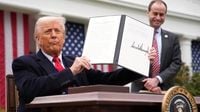U.S. automakers are sounding the alarm over President Donald Trump's recent trade agreement with Japan, warning that it unfairly favors Japanese car manufacturers and undermines the "America First" agenda that the administration has championed. The deal, announced on July 22, 2025, reduces tariffs on Japanese automobiles and car parts to 15%, a significant drop from the 25% tariff Trump initially threatened to impose earlier this year. Meanwhile, American car companies continue to grapple with steep tariffs—up to 50%—on imported steel and aluminum, essential materials for building vehicles domestically.
Matt Blunt, president of the American Automotive Policy Council (AAPC), which represents the Detroit Big Three automakers—General Motors, Ford, and Stellantis—expressed deep concern about the deal. "Any deal that charges a lower tariff for Japanese imports with virtually no U.S. content than the tariff imposed on North American-built vehicles with high U.S. content is a bad deal for U.S. industry and U.S. auto workers," Blunt told Car and Driver. This sentiment echoes the frustration felt by the United Auto Workers (UAW) union, which stated it is "deeply angered" by the agreement, arguing that it gives Japanese automakers "another break—at the expense of the very companies and workers that built the American auto industry into the global standard for good jobs and world-class products."
Indeed, the trade deal's terms have sparked fears that it could erode the competitiveness of American-made vehicles, especially in key manufacturing states like Michigan and Wisconsin, where auto plants are economic lifelines for working-class communities. The UAW warned, "If this becomes the blueprint for trade with Europe or South Korea, it will be a major missed opportunity. We need trade deals that raise standards—not reward the race to the bottom. This deal does the opposite." The union's criticism highlights a broader concern that the agreement may set a precedent for future trade negotiations that could further disadvantage American workers.
Adding to the complexity, the deal leaves tariffs on vehicles and parts imported from Canada and Mexico at 25%, even as Trump has threatened to raise those tariffs to 30% and 35%, respectively, starting August 1, 2025. This uneven tariff landscape has raised eyebrows within the industry, as it appears to single out Japanese automakers for preferential treatment while maintaining harsher measures on North American partners.
Financially, the impact of tariffs on U.S. automakers has been severe. General Motors reported a $1.1 billion hit to its operating income in the second quarter of 2025, with profit margins dropping from 9% to 6.1%. Stellantis, which owns Chrysler and Jeep, has incurred €300 million ($349.2 million) in tariff-related costs and experienced a 6% decline in vehicle shipments. Ford projected in May that tariffs would cost the company $1.5 billion in 2025 alone. These figures underscore the tangible toll that trade policies are taking on American manufacturers.
Despite these challenges, U.S. automakers have been absorbing much of the cost rather than passing it on to consumers. Average new car prices have increased only 1.2% year-over-year, a modest rise considering the tariff pressures. However, this strategy squeezes profit margins and limits the ability of companies to reinvest in innovation and domestic production.
Meanwhile, Japanese automakers have demonstrated resilience and strategic agility amid the shifting trade landscape. The U.S.-Japan deal's reduction of tariffs from 25% to 15% has provided immediate relief, allowing companies like Toyota, Honda, and Nissan to accelerate investments in the United States. Toyota, for instance, is expanding its electric vehicle (EV) battery production with a $12 billion project in Texas, aligning with U.S. green energy incentives and circumventing tariff barriers. Honda has restructured its supply chains to source more components domestically, ensuring compliance with the United States-Mexico-Canada Agreement (USMCA) content requirements.
These moves have helped Japanese automakers stabilize their market share and position themselves for long-term growth. Analysts project a 28% profit improvement for Honda and an 8% gain for Toyota under the current tariff framework. Toyota's healthy 10% operating margin enables it to absorb short-term tariff impacts while investing heavily in U.S. production capacity.
The trade deal also includes a pledge from Japan to invest $550 billion in the United States, with the U.S. expected to receive 90% of the profits. The White House has indicated that these investments will target sectors such as energy production, semiconductor manufacturing and research, pharmaceutical manufacturing, and commercial and defense shipbuilding. Japan has agreed to increase purchases of U.S.-grown rice by 75% and to buy $8 billion worth of corn, soybeans, fertilizer, bioethanol, and sustainable aviation fuel, among other products. While details about the $550 billion investment fund remain unclear, the commitment signals a significant economic partnership component within the trade agreement.
Nevertheless, skepticism remains among U.S. industry leaders about the practical impact of these provisions. Matt Blunt expressed doubts about the ability of U.S.-made vehicles to penetrate the Japanese market, noting that American cars accounted for less than 1% of passenger vehicle sales in Japan in 2023. Cultural preferences for smaller cars, differences in driving orientation (Japan drives on the left side of the road with right-hand steering wheels), and the dominance of domestic brands make meaningful market share gains challenging. "Japan is a tough nut to crack," Blunt told PBS.
On the political front, the deal has drawn mixed reactions. White House spokesperson Kush Desai defended the agreement as "a historic win for American carmakers by putting an end to Japan’s unfair auto trade barriers for American-made cars." Yet, critics argue that the deal's preferential treatment of Japanese imports undermines U.S. workers and manufacturers, contradicting the administration's stated goals.
The automotive sector's response to Trump's tariff regime illustrates a complex and evolving trade environment. U.S. automakers face short-term financial pain and a challenging path to reshoring production, while Japanese companies leverage lower tariffs and strategic investments to strengthen their foothold in the American market. The disparity in tariff treatment—lower rates for Japanese imports versus higher costs on U.S. manufacturers' raw materials—raises fundamental questions about the fairness and long-term sustainability of current trade policies.
As the administration prepares to review trade agreements and potentially impose new tariffs, the stakes remain high for American workers, manufacturers, and consumers. The unfolding situation underscores the delicate balance between protecting domestic industries and engaging in global trade partnerships. For now, the U.S. auto industry is bracing for continued turbulence, hoping for policies that truly support American jobs and innovation rather than tilt the playing field in favor of foreign competitors.


